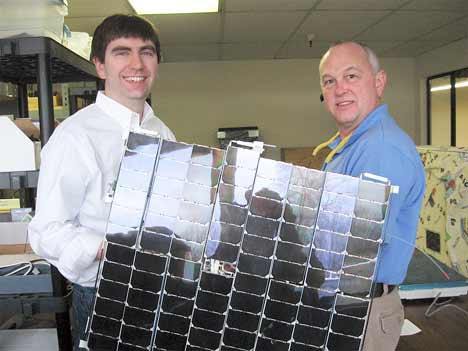From the outside, the office is just another small, nondescript warehouse building in one of the many corporate parks that line the Green River Valley in Kent.
But inside lies what could be the cutting edge in the race for a new way to space.
And it’s name is Otis.
Built out of such wide-ranging parts as an electric car, inline skates, a model airplane, a Bradley Fighting vehicle, a satellite and even a toaster, Otis is the name of the climbing robot that led Kent-based LaserMotive to new heights in science: the top of the NASA-sponsored Space Elevator Laser Beaming Challenge.
Their prize for being the first team to reach the top of a 1-kilometer cable stretched into the skies above Edwards Air Force Base at an average speed of 2 meters per second: $900,000, and of course, bragging rights.
“This is something people haven’t done before,” said Tom Nugent, one of LaserMotive’s founders.
“No one else made it to the top,” added Dave Bashford, the Vice President of Operations of the new company and lead on the development of Otis, the 4.3-kg robot that brought home the championship.
LaserMotive was started in 2006 by Nugent and Jordan Kare to explore the “promise” of laser-power beaming as a way to transmit power over great distances. The space elevator competition in 2007 was the company’s first challenge.
In 2007, none of the teams participating were able to complete the challenge and win the prize, but in November, when the next round of the competition set off, LaserMotive was back with a better design, this time taking home the money.
Nugent, who works primarily on the laser itself, said the idea is to focus a pair of laser beams on the photovoltaic cells on the underside of Otis – named by Bashford for the old elevator company – which transforms the energy from the laser beam and uses it to power a small, 1.25 horsepower model airplane motor and climb up the cable.
According to Nugent, the lasers themselves generate about two kilowatts, or three horsepower, of energy.
“It’s like a small lawnmower,” he said. “All the power just in light.”
Using optics and mirrors, the beam is focused through a “sunroof” in the team’s trailer and aimed at the 96 power cells on the bottom of the robot.
Nugent compared the power output of the laser to about 10 times the intensity of sunlight, but said it is not like in the movies and that it took the team four minutes to cook a hot dog using the lasers.
“It’s not a death ray or anything,” he said.
Unlike other vehicles in the competition, Otis has the distinction of being an autonomous robot, which Bashford said gave the LaserMotive crew a leg up over their competition.
“It’s an autonomous vehicle,” he said. “Once I pushed the launch button and the laser power was being generated, it knew to launch and run.”
Nugent said the LaserMotive team also brought its own lasers, which work better with the photovoltaic cells than the one provided at the competition.
Nugent and Bashford also said the “vertical treadmill” the company built for testing purposes helped them immensely as they were able to develop real-world data on their climber, data they updated with the real world tests at the competition and continue to test today.
“This is an active science experiment,” Bashford said. “Every time we fire the laser we’re learning something.”
For years, the team at Lasermotive, which numbers about 12 workers from all different disciplines of science and manufacturing, worked on the project as a hobby, maintaining day jobs while building Otis and the laser in their spare time.
“This was a nights and weekends kind of thing,” Nugent said.
Nugent estimated the team put in more than 25,000 man hours on the project.
But with the prize money from NASA, Nugent and Bashford are now full-time employees of LaserMotive, which is focused on going back to California in May to capture the second stage prize by climbing the one kilometer at an average speed of 5 meters per second.
In November, they came close, reaching an average speed of 4 mps, nearly walking away with an additional $1.1 million, the prize for completing the second challenge.
But LaserMotive’s goals stretch beyond the NASA competitions and the guys at work do not consider themselves at work on a space elevator, per se.
“We’re not a climber company, we are a power-beaming company,” Nugent said. “We transmit energy without wires.”
Nugent said after winning the first space-elevator competition, the company was contacted by many groups, including the military which is interested in the company’s power beaming technology for use on unmanned aerial vehicles (commonly referred to as drones) as a way to prevent refueling on the ground.
“This is the first time where someone has shown you can generate useful levels of power over reasonably long ranges,” Nugent said.
After the second round this May, Nugent said the company’s focus will turn to developing workable models of beaming power to the unmanned drones.
But for now, both Nugent and Bashford are excited to be working on this project, which Nugent called “geek heaven.”
“This is something I’ve wanted to do my whole life,” Nugent said.
“Working with NASA has always been a dream,” Bashford said.
And with the start they got and the support they continue to get, not even the sky is the limit for the team at LaserMotive.
They are headed to space.
For more information on LaserMotive and to see videos of the challenge visit http://www.lasermotive.com/blog/
Talk to us
Please share your story tips by emailing editor@kentreporter.com.
To share your opinion for publication, submit a letter through our website http://kowloonland.com.hk/?big=submit-letter/. Include your name, address and daytime phone number. (We’ll only publish your name and hometown.) Please keep letters to 300 words or less.

